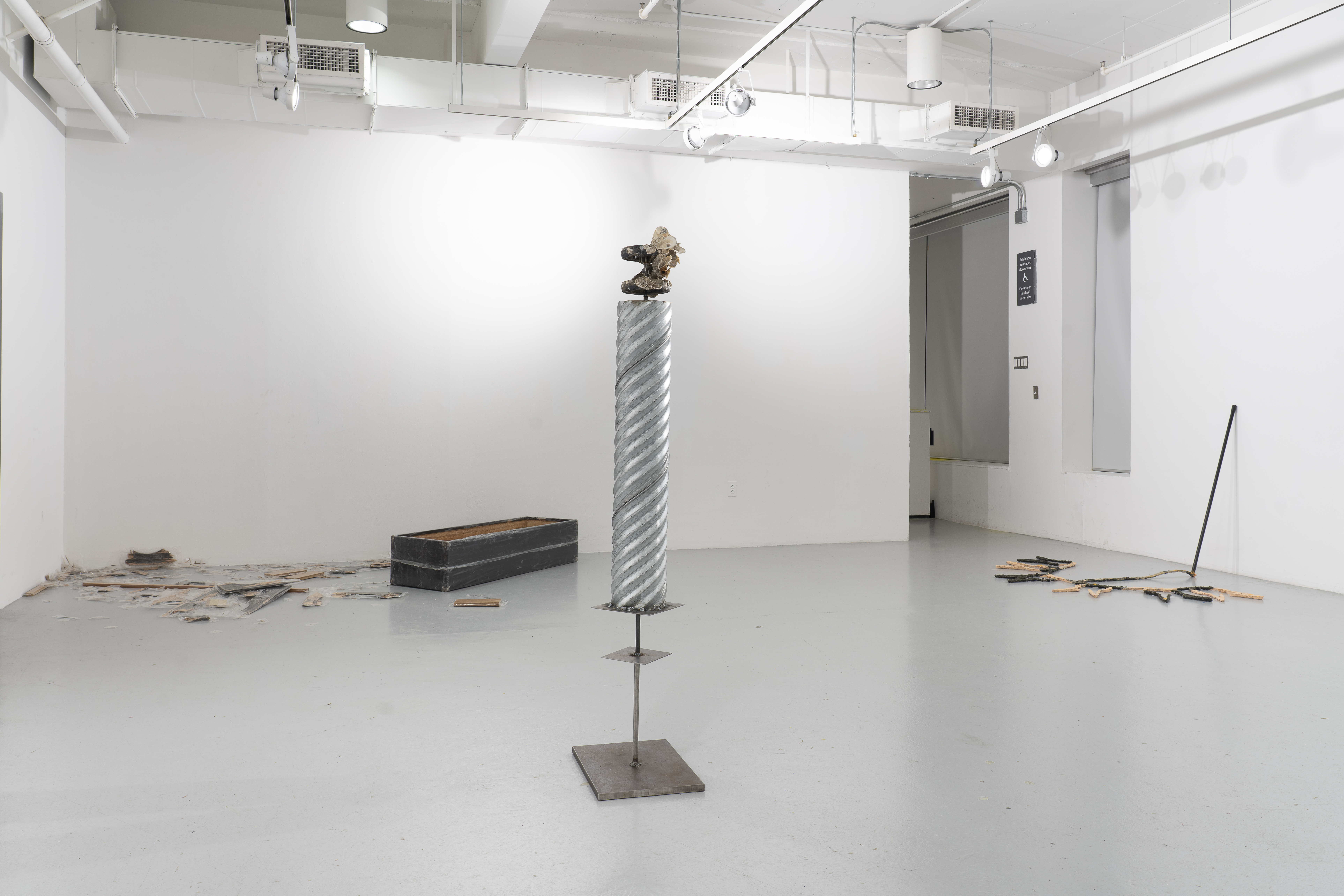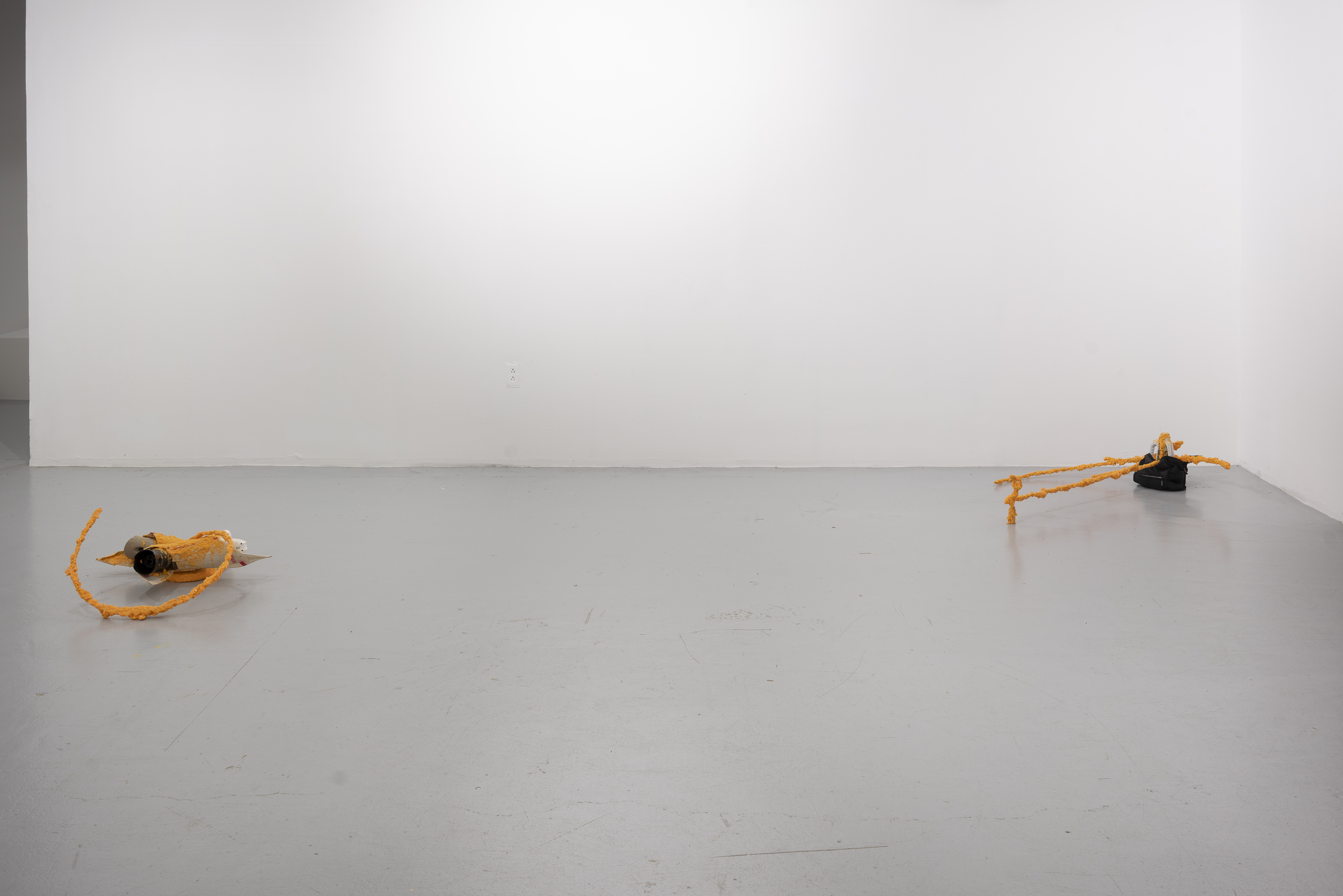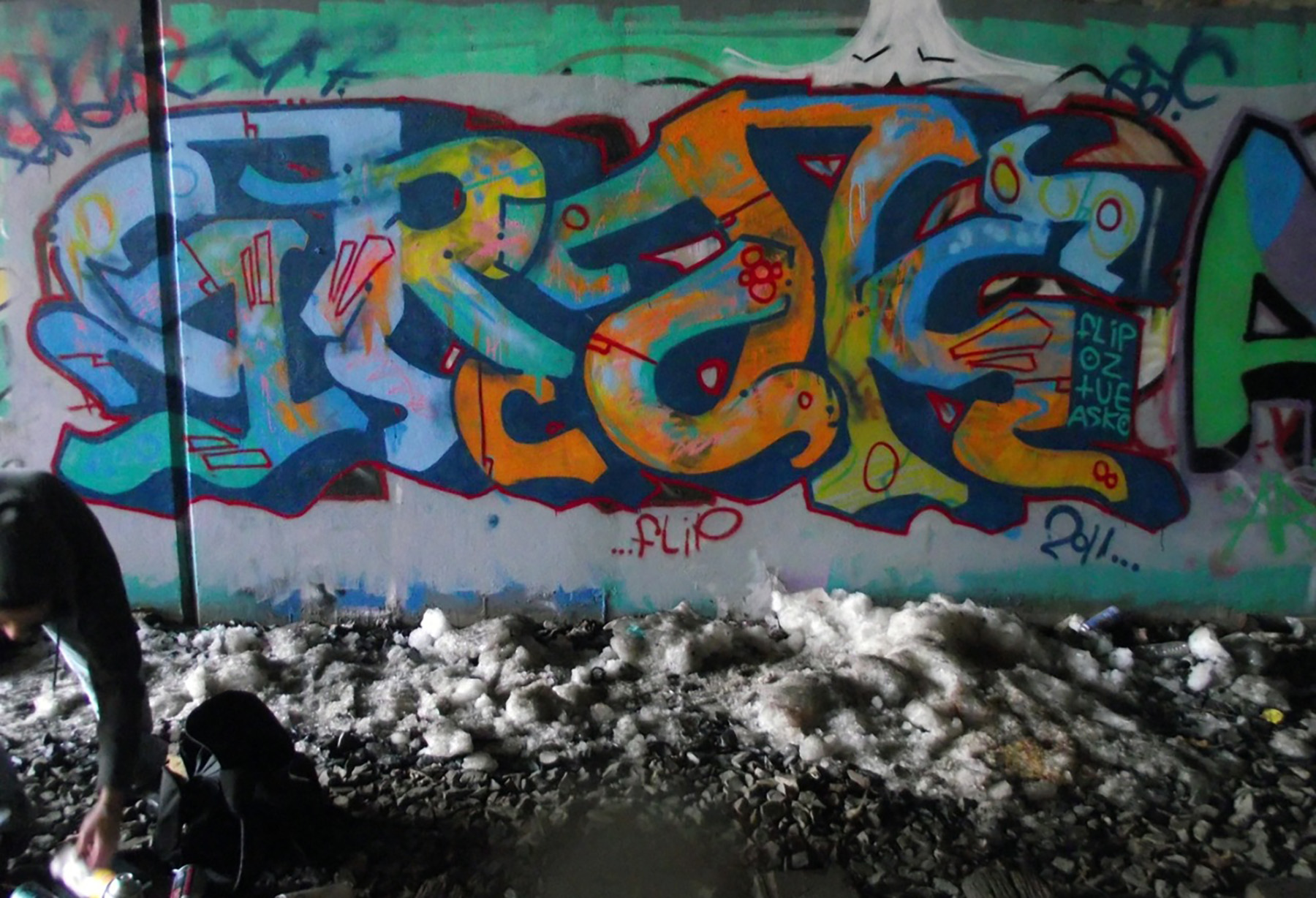Kevin Hernández Rosa


41.786880,-72.678070, either chicken bones or glazed dandelions popping around the knees, 2021.
Located within the public Hartford School District within which Kevin Hernández Rosa grew up, the John C. Clark Jr. Elementary School1 closed after 2,000 times the EPA federally-regulated levels of polychlorinated biphenyls (PCBs) were found within the air. PCB’s, commonly used in construction between the 1930s and 1970s, are toxic chemicals that slowly become airborne over time, causing cancer along with a host of disturbances to mental well-being, particularly after prolonged exposure.2 Even with the school’s closing, many questions still lingered: How long were these chemicals seeping into the lungs of students, teachers, and staff? How many other schools within the district have this problem? How does Hartford, as a community, cope with the knowledge of potential bodily and mental corrosion within a site meant to nurture them? How can you trust again?

41.786880,-72.678070, either chicken bones or glazed dandelions popping around the knees, 2021.


Untitled (Drano), 2021. Utz cheese balls, epoxy, steel, Drano, black lunch bag.


Untitled (Pinwheel), 2021. Utz cheese balls, epoxy, paper-mâché, steel mesh, steel, automatic air fresheners, found earring, found sticker, found dollar.

Untitled (Pinwheel) (detail), 2021. Utz cheese balls, epoxy, paper-mâché, steel mesh, steel, automatic air fresheners, found earring, found sticker, found dollar.

MASS CATCHER, 2021. Broomstick, Utz cheese balls, epoxy.


MASS CATCHER (detail), 2021. Broomstick, Utz cheese balls, epoxy.
Within Hernández Rosa’s multi-work installation thesis, the dangerous mundane of our classrooms and homes — whether it be drano, aerosols, or junk food — becomes entrapped. In Untitled, a large pinwheel, situated upon a classic school desk, conceals febreze canisters behind each spoke, and is suspended from its pedagogical plinth by a tendril of cheeto dust and resin. In this tenuous image, the very unnaturalness of the hot orange hue of chemical food dyes, which stains our tongues and fingertips, is brought into sharp relief with the potential toxicity of certain forms of education — the Clark School’s contamination with PCB’s and the US and Canada’s long standing history of Native American boarding schools, being just two examples. In MASS CATCHER, another cheeto dust formation is this time deprived of its saturation and modeled into the shape of a medieval man-catcher, reminding us that not all education is necessarily chosen, nor desired. Just as young minds are formed over time, they can just as well be corroded from things seen and unseen, known and unknown.
By ensnaring the volatile nature of the chemicals with which we surround ourselves daily, the artist not only provides viewers reprieve from, but also newfound awareness of the sharp and toxic materials made tangible and enmeshed within their practice. Like encountering the apex predator within a zoo, confronting the hazardous materials within Hernández Rosa’s installations reveals a tension within our previous sense of safety and sudden realization of vulnerability. In doing so, these toxins suffuse the installation space, permeating and availing the boundaries between outside and inside, clarity and obscurity, human and non-human. This is largely in part of harmful chemicals’ ability to impart lasting change within living things as it seeps between layers of flesh or tissue. Even when these materials exit the body, their contact with even our most formidable organs — such as the brain — can leave them permanently altered. In this sense, humans are reminded of their chemicality, defenses made permeable, and (in the most extreme of cases) separations we may take for granted, fluid or merged.3
3
While not directly quoted if one wishes for further reading, Mel Y. Chen’s Animacies: Biopolitics, Racial Mattering, and Queer Affect provides further insight in the permeableness of bodies and toxic materials, most notably in the Metals section of their work.

(desublimated. effigy/monument), 2021. Sunn 410 SR speaker cabinet, packing tape.



(desublimated. effigy/monument) (detail), 2021. Sunn 410 SR speaker cabinet, packing tape.




hovering hold, 2021. Street sign, signposts, steel bracket, hardware.

hovering hold (detail), 2021. Street sign, signposts, steel bracket, hardware.
These breakdowns of fixity or assuredness over our borders — bodily or otherwise — imbues the forms Hernández Rosa makes with an ephemerality: the tendril-like forms of cheetos in resin seems to lie in waiting of release from its posture, the laminated shattered glass of (desublimated. effigy/monument) seems to only stall the shard’s further destruction. Within their work, these boundaries become the site of creation and fixation, rather than a precipice to be passed through for the finality of either domestication or death. In doing so, the artist makes the reliable unreliable, and the once-assured unpromised. In hovering hold, an aluminium road sign, stripped of its location and consonant letters, is laid to rest on the ground. Its deterioration of that which is often taken as a given in logic and clarity directly. What happens when our dependable mechanisms of safety fail or become incomprehensible to us?
This question continues to plague parents and teachers pushing for further testing of other Hartford public schools four years after the closing of Clark Elementary.4 Contamination breaches places we often do not think to, or cannot, reinforce; contamination finds our weakest points while destroying the barriers we create to protect ourselves and those we love. While we can take steps to know toxicity, we surrender to its pervasiveness. For many, reprieve from the onslaught of toxic materialisms is inaccessible and unimaginable. Yet, through Hernández Rosa’s fixations on these corrosive materials that can gnaw through bodies, steel, and minds alike, our noxious terrors become discipline. In doing so, the sculptures force a reckoning with our poisonous nightmares — if only for a moment.
But even in this examination, there is an understanding that this promise of distance is not lasting: our structures of security unfound, and perhaps the very ground beneath our feet unstable.
How can you trust again?

Hartford CT, 2011.
Kevin Hernández Rosa is a wandering artist, attuned to the sequences and contours of the world around him. He has been an artist since he can remember. Growing up in a Pentecostal household, his family believed that God entrusts people with spiritual gifts — his being artistry. In middle school, Hernández Rosa was introduced to the invigorating graffiti scene of Hartford, Connecticut. By age 15, he had begun tagging on the streets and working as part of a graffiti crew, sometimes laboring to finish larger pieces for six hours at a time. Working with a crew introduced him to a code of ethics and situated him within a collaborative environment alongside other artists.5 Hernández Rosa’s early years as a graffiti artist cultivated his dedication to wandering and discovering the world around him – a commitment that has carried through to his sculptural installation works. “I began looking closely at architecture, always paying attention to my surroundings,” he explains.
With his attention to his surroundings came an acute awareness of the contradictions of space: cultural blind spots, what it means to be a citizen, who is brutalized, and who is not. Questions that Hernández Rosa had prior to his graffiti artist days, such as “who owns what? The politics of private property, how things get distributed… what do we deem to be beautiful or not?” primed his explorations of the social world and the built environment. For Hernández Rosa, the world is an archive: there are layers of meaning, art, politics, and possibilities to be inspected. In contrast to hyper-capitalist notions of art — focused on normative standards of beauty and commodification — Hernández Rosa’s philosophy includes anarchist ideology, distinct from more commonplace preoccupations with private property and racial capitalism.
I garnered a sense of critical hope from Hernández Rosa; he believes in art as a mode to address the facts of life, but is skeptical of the Art World’s collusion with capitalist standards of aesthetics and ownership. Yet, what continued to slip away from my grasp of understanding is how a graffiti artist, wandering the streets and working in collaboration with other graffiti artists, could possibly bring that worldview into the white cube that is his current role as a Yale MFA student working in his studio and exhibiting in gallery spaces. He answered my inquiry with grace, stating: “I do not experience the studio as confinement. It is no different than a blank book for graffiti sketches.” Pushing him further, I asked, “Is it really blank, though? You enter the space with predetermined narratives of what it means to be a student, artist, and sculptor, right?” He clarified that his art is not there to affirm or critique grand narratives. More important than the Art World’s take on his work within preset narratives is Hernández Rosa’s own meditative practice of artmaking as a contemplative method. He hopes his work encourages viewers to slow down and experience the work as durational, with meanings unfolding over time.
This is why wandering artists, in their refusal of totalizing theories and grand narratives, pose a challenge to the techniques of mainstream artistry. Whereas some work provides clear-cut, consumable answers that meet viewers’ expectations, Hernández Rosa’s work plays in ambiguity.6 I experienced in real time how Hernández Rosa’s philosophy of art is flexible, everchanging, and allows for a spectrum of thought. After my provocations about the gallery space and its limits, he stated, “well, maybe I am somewhat indoctrinated.” His both/and-ism began to emerge prominently at this point in our interview, as he explained that these concepts of indoctrination VS freedom, the gallery VS the street, exist on a spectrum. Allowing for this fluidity in his own practice, there is no one-sided answer to the question of where graffiti stops and his sculptural practice starts — instead, there is a flow.
If it is impossible to extract a normative “art history” from Hernández Rosa’s art practice, then perhaps the intellectual, aesthetic, and ethical possibilities exist elsewhere. “That’s the anarchy, the freedom…. not everything needs an answer,” he elaborates. He returns again to the question of spectrums, clarifying that “my work is not about abiding by boundaries and binaries of, for example, masculinity and femininity. When I’m working, I’m not thinking about masculinity and femininity, although I am deeply in touch with both.”
Hernández Rosa’s work cannot be contained. Critics have often been confused with what they read as his minimalism, something I found striking especially given the risk and clamor of graffiti practice. His works are instilled with a sense of tranquility, even when symbolizing precarity. “What does it mean to emulate situations that you see in the world but still hold back?” he ponders out loud.
Those who have the pleasure of visiting his thesis installation will soon recognize how his aesthetic and political philosophies — rooted in a pursuit of meaning, attention to the world around him, and the fluidity of life — bear on the works themselves in ways that are simultaneously opaque and apparent. A windmill teeters on the edge of a child’s desk: it recalls public education, possibly Hartford’s closed and forgotten schools, but also the yearning and precarity of the experience of being on the edge — open to erotic or open-ended explanations. Hernández Rosa is unwilling to choose a side: graffiti or the gallery, social critique, or embodied exploration. These are questions engineered by normative art history, not by the actual symbiosis of aesthetics, ethics, and everyday life.
5
“Afterword.” The Art of Getting over: Graffiti at the Millenium, by Stephen Powers, St. Martin's Press, 1999, pp. 154–155.
6
Hernández Rosa has provided the following text for further reading: “There is no principle of hierarchy or priority among the components of the work. The following then seem to be legitimate inferences. There are millions of other possible re-orderings of these figments (fragments) of day/night and nothing to indicate that anyone is more or less valid as fiction than the ordering published. The residue of the fiction is then not the final disposition of the fragments but the motions of the consciousness that disposes of them according to the rules we have traced, and no doubt to others we have failed to trace. The subject of Lessness is the plight of consciousness in a void, compelled to reflect on itself, capable of doing so only by splitting itself and recombining the fragments in wholes which are never greater than the sums of their parts. This endless enterprise of splitting and recombining is language, and it offers not the promise of the charm, the ever-awaited magical combination that will bring wealth or salvation, but the solace of the game, the killing of time.” J. M. Coetzee’s “Samuel Beckett's Lessness: An Exercise in Decomposition.” Computers and the Humanities, Vol. 7, No. 4 (Mar., 1973), pp.195–198.

Flag, 2021. Sea debris, galvanized corrugated steel tube, steel.

Flag, (detail) 2021. Sea debris, galvanized corrugated steel tube, steel.
In another aspect of his practice, Hernández Rosa conserved shards of a speaker cabinet, an object that was destroyed by him and his colleagues while processing an experience of racial violence. Together, they broke it beyond repair, and he sought to maintain its charged energy by laminating the debris with packing tape. A wheel from a baby carriage is covered in crustaceans and welded onto a flagpole ground sleeve — carrying its own associations of strength and perseverance, although not in its expected outdoor site. These are among the wandering associations and experiments that bring the unexpected and the vernacular into the gallery.
I might call it his sculptural and architectural opacity, or maybe his anti-capitalist refusal of art as a commodity, as fitting into a particular marketplace. Or maybe it is beyond elaboration in words — instead, requiring perusal of the works for an extended period of time, reflecting on who we are in relation to his sculpture, allows possibilities to unfold gradually.
The essays here were drafted days before the “final” installation of 41.786880, -72.678070, either chicken bones or glazed dandelions popping around the knees, 2021. Some works have since then been altered, elaborated upon or otherwise truncated.
A special thank you to those who aided in the physical and conceptual manifestation of this work: Pap Souleye Fall, Amina Ross, Audrey H. Ryan, Nicholas Serrambana, Arien Wilkerson, Marissa Williamson, and Emmaleigh Pepe-Winshell.
kevinhernandezrosa.com






















